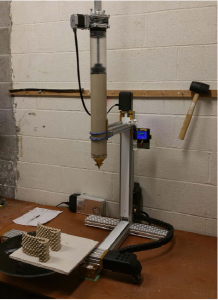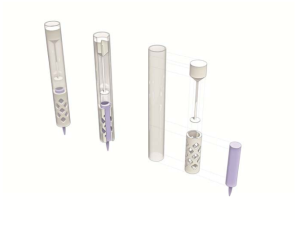3D Printed Concrete for Building Structure and Construction
Submitted by our 2016 ARC Fellow Team:
Richard Kuo (College of Environmental Design, and Department of Civil and Environmental Engineering) and Ron Rael (Architecture, Art Practice)
1. Introduction
3D-printing technology has grown and prevailed in the architectural and building industry. The main advantages to use the 3D-printing technology for building structures include the ability to achieve a more complex geometric structure, quicker construction, lower labor and construction costs, and produce less waste. With the advancement in 3D-printing technology, many materials can now be printed, including metal, earthy material (e.g., clay, mud, concrete, mortar, sand, etc.), and fiber polymers (e.g., PLA, ABS, FRP, carbon fiber, etc.). It is possible to use mixed materials to increase strength and durability of the composite materials [4].
2. Objectives
The main objective for the research is to gain understanding on the properties of 3D-printed fluid-dense materials by using a clay extrusion 3D printer. The collected test data and experienced gained will help to 3D print concrete mixture in the future that can be applied to furniture, pavilion, real building-scaled structures, long span structures and bridges, outer space bases and many more.
3. Methodology
3.1. 3D Printing Clay
The first step of the research experiment is to learn how to use an existing clay 3D printer, the Potterbot in the College of Environmental Design. The machine consists with a moving XY plate and Z extruder that pushes clay through a metal nozzle from cylindrical acrylic tube. Once a digital 3D file is made, it can be sent to the Potterbot and print the clay specimen. The natural properties of moist clay are viscous, sticky, cohesive body, which is ideal for stacking. Clay’s fine particle allows it to flow through the small metal nozzle from extrusion easily. Since it is highly malleable, a wide variety of geometry can be made by 3D printed clay with the Potterbot, such as cups, vases, sculpture, claddings, bricks, etc
3.2. 3D Printing Silicon, Grout, and Construction Adhesive
Since silicon has similar fluid-dense properties as clay and wet concrete, extensive 3D printing experiments were done with the modification of the Potterbot. To fit the commercial silicon tubes in to the larger diameter Potterbot cylinder tubes, a custom made of 3D-printed plastic adapter kit was created to properly fit them in place for extrusion, as shown in Figure 2. Silicon caulk, sandy grout, and construction adhesive were tested on the modified Potterbot printer. A simple cylinder shape was tested with these materials.
Through a series of test print, a major challenge has posed that impede the research progress. Because silicon, grout, and construction adhesive are softer than clay and doesn’t have the cohesive body to free stand, it collapsed and warped easily once they were printed above 1.5-inch height for a single layered wall. The longer curing time also makes the lower layer silicon vulnerable to collapse when more and more layers were stacked on top.
A solution Professor Ronald Rael came up with is to combine the 3D extrusion technique and the powder print technique. While printing the silicon specimen in a box, sand is poured slowly and constantly around the object. The rate of sand pouring is the same as the rate of 3D printing process, which allows the sand on both sides of the silicon wall to provide equal lateral support pressure to prevent buckling and warping. The experiment resulted in successful printed samples that have printed height beyond 4-inches, with sand covering the specimen skins, as shown in Figure 8.
3.3. 3D Printing Concrete
With the success of 3D printing silicon caulk, grout, and construction adhesive with the sand box method, 3D printing concrete mixture was conducted. Typical concrete mixture is composed of cement, sand, and gravel at a ratio of 1:2:3 with adequate amount of water. Since the Potterbot’s nozzle was relatively small to gravel, only water, sand, and cement were used. To find the perfect concrete mixture ratio, a series of slump test was conducted to find which mix ratio of water, cement and sand will perform the best, which has a fluid-dense nature like silicon but also pose a cohesive body like clay.
However, since there was no continuous blending mechanism, the mixture ratio become inconsistent easily inside the Potterbot’s cylinder tube. Water and sand separated easily inside 8 the tube; sand slinked down to the bottom of the tube and clogged the nozzle that prevented the mixture to be extruded. In the end of experiment, only water was dripping from the nozzle while no cement mixture came out.
4. Conclusions
The potential of 3D printed high-performance fluid-dense composite materials such as grout and concrete has numerous potentials and benefits in the building industry: architects can design geometrically complex buildings, engineers can enhance structural strength while reducing the material weight, contractors can cut down construction costs by using less labors, formworks, and transportations, the owners can expect the construction to be completed in much shorter time. The research experiment helps to gain significant understanding on the feasibility of 3D printing construction material at a smaller scale. With the help of sand box method, less viscous materials still can achieve complex geometry and adequate print height. Although 3D printing concrete mixture was not a success, future work on tweaking the printer’s extrusion rate and print speed, as well as experimenting different concrete mixture ratio will improve the experiment results. The research team hoped that this work can inspire and help to create a building environment that is more aesthetically pleasing, engineering efficient, sustainable, and economical.
References
[1 ] B. Khoshnevis, “Automated construction by contour crafting—related robotics,” Automation in construction, vol. 13, no. 1, pp. 5-19, January 2004.
[2] Cesaretti, G., Dini, E., De Kestelier, X., Colla, V., & Pambaguian, L. , “Building components for an outpost on the Lunar soil by means of a novel 3D printing technology,” Acta Astronautica, vol. 93, pp. 430-450, January 2014.
[3] Rael, R., & San Fratello, V., “Rael San Fratello, Bloom,” 2015. [Online]. Available: http://www.rael-sanfratello.com/?p=1830. [Accessed October 2015].
[4] Rael, R., & San Fratello, V. , “Developing Concrete Polymer Building Components for 3D Printing,” ACADIA, 2011.
[5] Le, T. T., Austin, S. A., Lim, S., Buswell, R. A., Law, R., Gibb, A. G., & Thorpe, T., “Hardened properties of high-performance printing concrete,” Cement and Concrete Research, vol. 3, no. 42, pp. 558-566, 2012.
Ronald Rael is an Associate Professor at the University of California, Berkeley with a joint appointment in the departments of Architecture and Art Practice. He is the author of Earth Architecture (Princeton Architectural Press, 2008) and the forthcoming book, Borderwall as Architecture (University of California Press 2017). His company, Emerging Objects is a pioneering design and research company that focuses on innovative 3D printed materials and objects for the built environment.
Richard Kuo is currently pursuing a master degree in architecture at the College of Environmental Design. With a civil engineering degree and relavent work experience in the building industry, he focuses on combining the engineering technology with architectural creativity. He ultimately hopes to utilize the knowledge acquried at UC Berkeley to shape an elegant, economical, and sustainable environment.
Note: Over the course of the spring semester, each 2016 ARC Fellows team will submit a short blog post about their project and findings. We hope you will enjoy these short readings! The Fellows Program advances interdisciplinary research in the arts at UC Berkeley by supporting self-nominated pairs of graduate students and faculty members as they pursue semester-long collaborative projects of their own design. To learn more about the program, click here.



